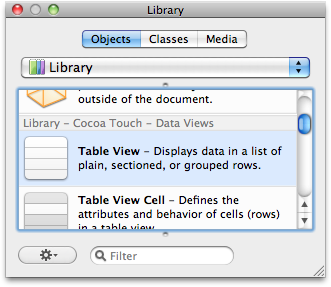Chapter 3. Constructing and Using Table Views
3.0. Introduction
A table view is simply a scrolling view that is separated
into sections, each of which is further separated into rows. Each row is
an instance of the UITableViewCell
class, and you can create custom table view rows by
subclassing this class.
Using table views is an ideal way to present a list of items to users. You can embed images, text, and whatnot into your table view cells; you can customize their height, shape, grouping, and much more. The simplicity of the structure of table views is what makes them highly customizable.
A table view can be fed with data using a table view data source,
and you can receive various events and control the physical appearance of
table views using a table view delegate object. These are defined,
respectively, in the UITableViewDataSource and UITableViewDelegate protocols.
Although an instance of UITableView subclasses UIScrollView,
table views can only scroll vertically. This is more a feature than a
limitation. In this chapter, we will discuss the different ways of
creating, managing, and customizing table views.
3.1. Creating a Table View Using Interface Builder
Problem
You want to create a table view using Interface Builder.
Solution
Drop an instance of the UITableView from the Library onto a container,
such as an instance of UIView (see
Figure 3-1).

Get iOS 4 Programming Cookbook now with the O’Reilly learning platform.
O’Reilly members experience books, live events, courses curated by job role, and more from O’Reilly and nearly 200 top publishers.

